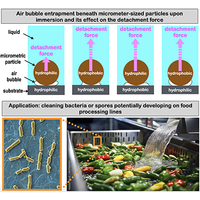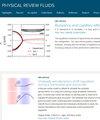Retention or repulsion forces induced by bubbles trapped at the base of an immersed microparticle on a substrate
IF 2.5
3区 物理与天体物理
Q2 PHYSICS, FLUIDS & PLASMAS
引用次数: 0
Abstract
We explore the potential for air bubble entrapment beneath micrometer-sized particles following immersion. This investigation employs theoretical, numerical, and experimental methodologies, with a focus on the wetting characteristics of both the particle and its substrate. These properties are crucial in determining the likelihood of entrapment and its impact on the particle's adhesion force to the substrate. The theoretical model provides the mathematical framework to account for the additional force exerted on the particle due to the entrapped bubble, while numerical calculations yield corresponding force values. The results underscore the significant influence of the wettability of both the particle and the substrate on this force. In support of findings of the numerical model, companion experiments were performed. The results demonstrate that the bubbles can indeed be entrapped at microscales underneath micrometric particles. Experimental measurements of detachment force reveal the substantial impact of these entrapped bubbles on the force required to detach particles from a surface. Specifically, the force appears notably higher when either the particle or the substrate, or both, exhibit hydrophobic characteristics. We highlight the alignment observed between numerical calculations and experimental results, while also examining and discussing any identified disparities and their root causes. Lastly, we propose an energy model that predicts the post-detachment configuration of the bubble, determining whether it remains attached to the particle, adheres to the substrate, or splits into daughter bubbles distributed across both surfaces. These findings hold significance for a wide range of industrial applications where the immersion of micrometer-sized entities, such as dirt or bacteria, is common during liquid-based cleaning processes.

浸入基底的微粒子底部的气泡诱发的滞留力或斥力
我们探讨了微米大小的颗粒在浸泡后被气泡夹住的可能性。这项研究采用了理论、数值和实验方法,重点关注颗粒及其基底的润湿特性。这些特性对于确定气泡被截留的可能性及其对颗粒与基底粘附力的影响至关重要。理论模型提供了一个数学框架,用于解释由于气泡被夹持而对粒子产生的额外作用力,而数值计算则得出了相应的作用力值。结果表明,颗粒和基底的润湿性对这一作用力有重大影响。为了支持数值模型的研究结果,我们进行了配套实验。结果表明,气泡确实可以在微米级颗粒下的微观尺度上被夹带。对脱离力的实验测量显示,这些被夹带的气泡对颗粒从表面脱离所需的力有很大影响。具体来说,当颗粒或基底或两者都表现出疏水特性时,分离力会明显增大。我们强调了数值计算与实验结果之间的一致性,同时还研究并讨论了任何已发现的差异及其根本原因。最后,我们提出了一个能量模型,该模型可预测气泡脱离后的构型,决定气泡是继续附着在颗粒上、粘附在基质上,还是分裂成分布在两个表面的子气泡。这些发现对广泛的工业应用具有重要意义,因为在基于液体的清洁过程中,微米大小的实体(如污垢或细菌)的浸入很常见。
本文章由计算机程序翻译,如有差异,请以英文原文为准。
求助全文
约1分钟内获得全文
求助全文
来源期刊

Physical Review Fluids
Chemical Engineering-Fluid Flow and Transfer Processes
CiteScore
5.10
自引率
11.10%
发文量
488
期刊介绍:
Physical Review Fluids is APS’s newest online-only journal dedicated to publishing innovative research that will significantly advance the fundamental understanding of fluid dynamics. Physical Review Fluids expands the scope of the APS journals to include additional areas of fluid dynamics research, complements the existing Physical Review collection, and maintains the same quality and reputation that authors and subscribers expect from APS. The journal is published with the endorsement of the APS Division of Fluid Dynamics.
 求助内容:
求助内容: 应助结果提醒方式:
应助结果提醒方式:


